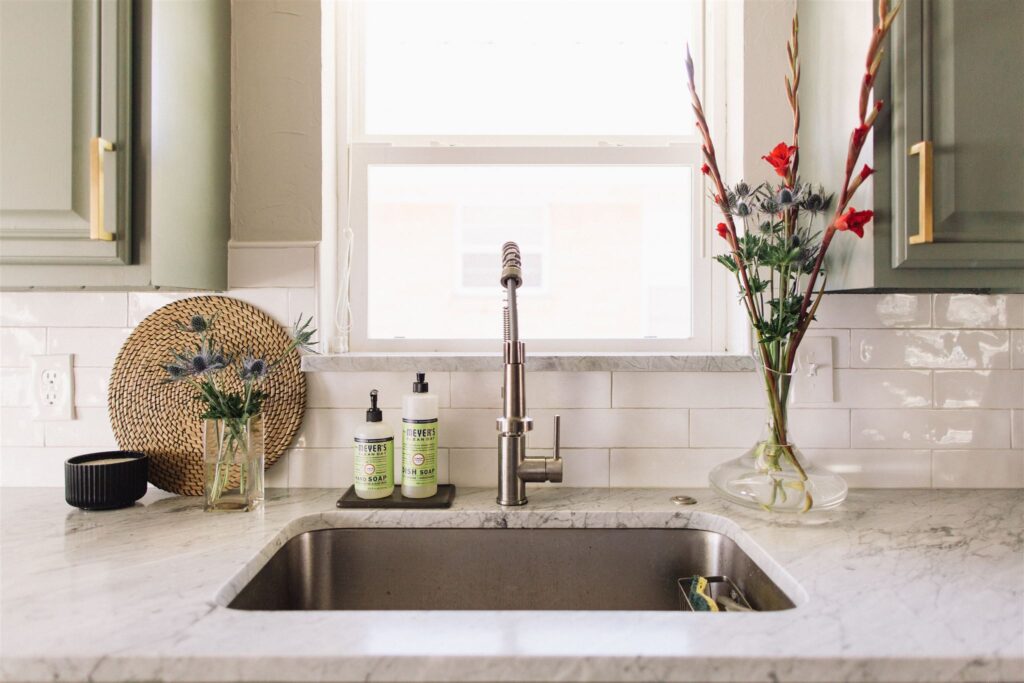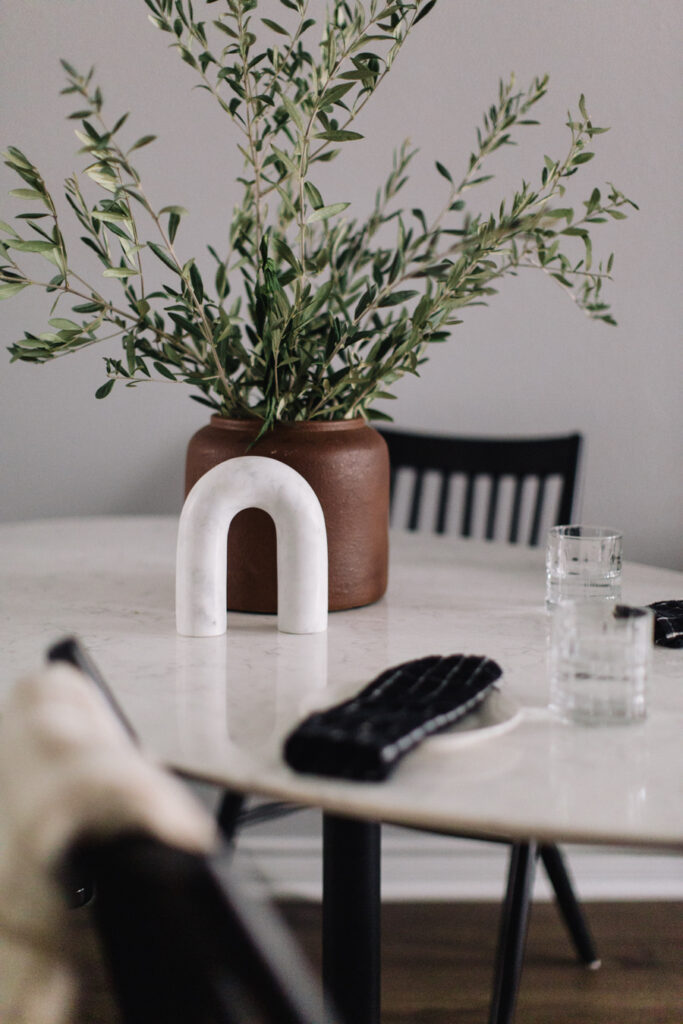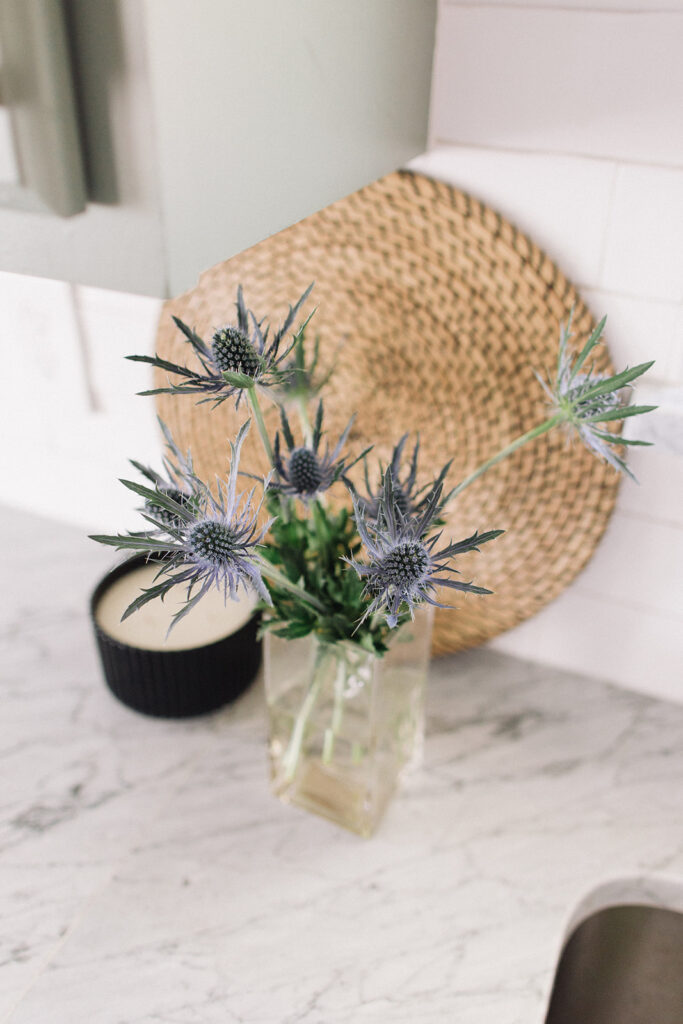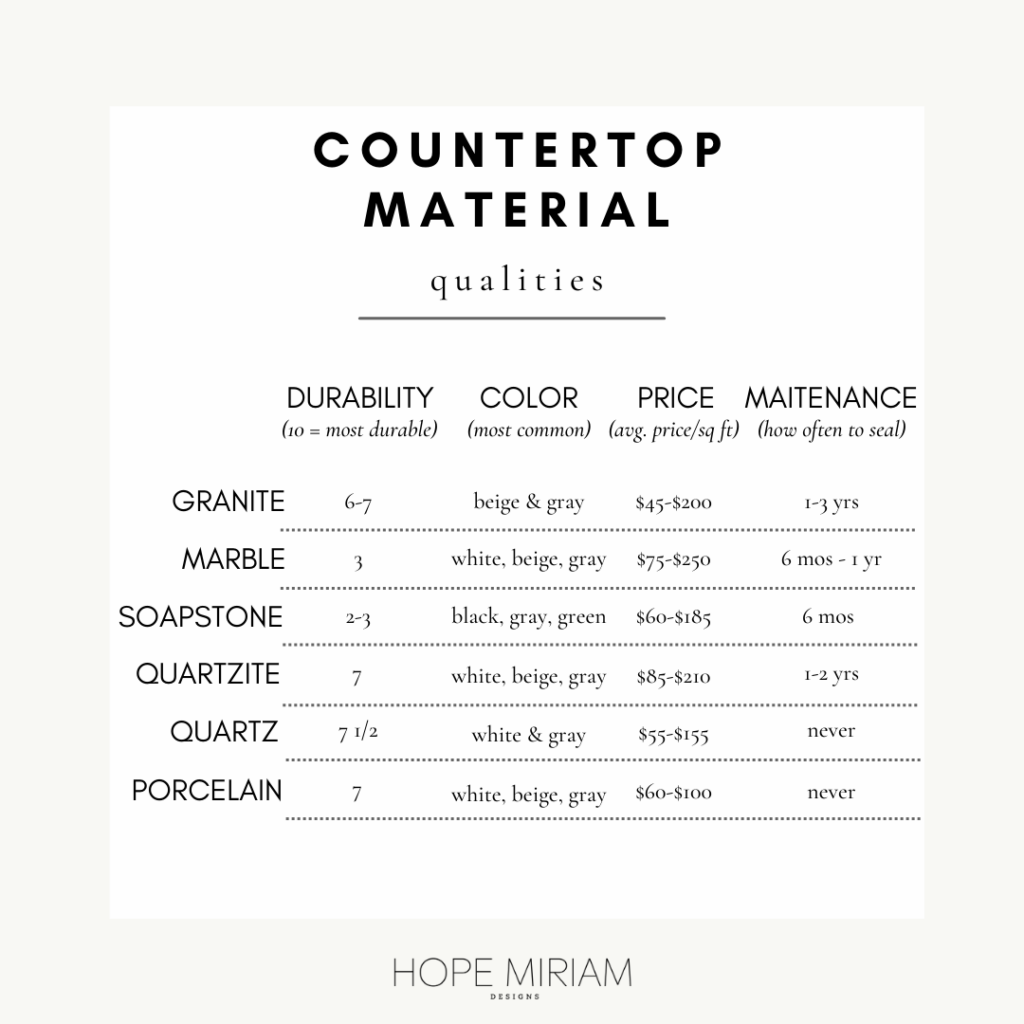HMD specializes on renovation projects that honor the home's character while adding a modern interpretation.
Explore The Blog
Home Rennovations
Do-It-Yourself
Home Styling
Favorite Things
Case Studies
4 Factors Designers Consider When Selecting a Countertop Material
Selecting a countertop material can be a fun yet daunting task. It’s mesmerizing to see the variety of options at a stone yard but how do you pick the right countertop? There are four main factors interior designers consider when selecting a countertop material. Find out what they are and why they matter!

1. | Durability
Not all countertops are made equal. It’s easy to look at Pinterest inspiration of kitchens but what you’re not able to see is how the countertop material wears over time. When it comes to durability, designers will typically ask their clients detailed questions on how they use their space. For a kitchen project a designer may ask, “Do you air dry dishes?” “Do you set hot pots directly on the countertops?” “Do you keep cooking oil sitting next to the stove?”
All these questions help the designer understand what level of durability is necessary. Once you know how you plan to use the space, then you’re able to weigh the different options. So what are the common materials used for countertops?
Natural Stones
At Hope Miriam Designs, we mostly work with natural stones. It’s hard to create the same depth and intrigue with a man-made material which is why so many high-end kitchens opt for natural materials. Natural stone countertops are mined in huge quarries and cut in thin slabs for use in the home.
Granite – This first stone option has historically been the most common material in kitchens. When it comes to durability, it is relatively heat and scratch resistant. The stone is also naturally porous but the fabricator will seal the stone after installation protecting it from staining.
Marble/Soapstone – These materials are popular on Pinterest because of their beauty but it’s important to understand the various aspects of their durability! They are not the right material for every home because they are a softer stone than other countertop materials. This means that they scratch more easily, do not tolerate heat, and are the most porous of the bunch.
Quartzite – Quartzite is one of the most misunderstood countertop materials. Often it is confused with the man-made material Quartz but is very different in appearance and slightly less durable. Quartzite is highly resistant to heat and resistant to water after sealing. It is more susceptible to scratches than granite yet is resistant to acids that can cause etching.
Engineered Stone
While man-made stone is manufactured, it is still composed from natural elements. This makes them extra durable which is why we have seen a rise in their popularity. Two engineered stones that we will use in our comparisons are quartz and porcelain.
Quartz – This material is one of the most durable countertop surfaces on the market. It is scratch resistant, naturally non-porous, and can withstand heat. Due to these properties, many manufactures offer generous warranties as a guarantee after installation.
Porcelain – Porcelain is another durable countertop material option. It is heat resistant and basically impenetrable by water. It is also scratch resistant but less so than quartz. One advantage that porcelain has over quartz is resistance to UV light. This means long exposure to sunlight will not change the stones coloring or appearance.

2. | Color & Appearance
Color, veining and the material finish are a few ways to add visual interest to a countertop surface. Varying combinations of these three visual elements can make a countertop stand out against other surfaces.
Pro tip: designers always bring cabinet color swatches and backsplash tiles when selecting the countertop. This not only helps to ensure the colors work well together, but also helps to see which stones may be too busy or simple.
As mentioned earlier, natural stone countertops are mined and cut. The method used to cut the stone is best compared to sliced bread. So if you select a natural stone with a specific pattern, you should be able to match the design with the cuts sequentially before or after, in the case you need more than one slab.
With engineered stone, there is high consistency between slabs because they are man-made. The downside to their appearance is they typically have less depth in color than natural stone.
Appearance Description By Stone
Granite – This material typically has a speckled appearance even in variants with a larger pattern. It can come in a range of colors from tan, beige, gray, red, or even black. Some of the most popular varieties are silver cloud, white ornamental, white ice and black pearl.
As for finishes, granite is most often polished when used as a countertop surface. A polished finish is glossy and has a sheen that reflects light. Other options for granite are honed or leathered. Honed has a matte natural appearance and leathered has a soft sheen with a textured appearance.
Marble – Marble is currently the most sought after look of all the stones. It is known for its organic veining pattern among various colorations. Marble is most commonly sourced in white, gray, and cream for countertops but also comes in black, red, blue, green, and brown tones. As for the finish, marble can come polished or honed in appearance. Leathering is possible but is less common than with granite.
Soapstone – Soapstone feels the most distinct in appearance compared to other stone materials. It comes in darker colors of green, gray, black, and blueish gray. Like marble, it often has veining patterns throughout the surface. For the finish, it can have a polished appearance by applying an oil or can be left honed.
Quartzite – This stone has lots of depth in appearance making it one of the higher-end options. A popular quartzite variety is Taj Mahal. From a distance is has a warm beige color and as you get closer you can see variants of gray, taupe, and cream throughout the slab. Most clients go into stone yards thinking they want a certain material and leave impressed by quartzite qualities. This material can have a polished, honed or leathered finish.
Quartz – Quartz is mostly manufactured in neutrals — white, gray, beige, and black. Since they are man-made through bonding ground materials, their appearance can lack dimension. Quartz is known to have veining patterns but some variants look forced in their movement. Finishes for this countertop are polished and honed.
Porcelain – Porcelain has a wider variety of color and pattern than quartz. It is a thinner material than most which also can impact the overall look of the countertop. This material is often seen polished but has the option of honed as well.

3. | Price
Factors that impact countertop material price are location of sourcing, the difficulty to extract, and the rarity of the stone. A common terminology of more expensive countertops is “exotic”, meaning they are made from a rare or unusual stone not found in traditional countertops.
The price ranges below are sourced from Countertop Guides [1] and while the cost can range by region, these numbers show a good relative comparison for each material.
- Granite countertop cost: $45-$200 per square foot
- Marble countertop cost: $75-$250 per square foot
- Soapstone countertop cost: $60-$185 per square foot
- Quartzite countertop cost: $80 to $210 per square foot
- Quartz countertop cost: $55-$155 per square foot
- Porcelain countertop cost: $60-$100 per square foot
On the low end, granite and quartz are two of the cheaper options. For more exotic variants, marble and quartzite can be the most expensive. During the process of selecting your countertop, it’s best to take a look at all the stone options and note your favorites. Then your fabricator should be able to come back with exact prices for your selections and quantities.
As a designer, I don’t like to rule out any category before making a selection. Often clients leave surprised by what they like best and depending on the scale of the project an extra $25 per square foot may not make that big of a difference.

4. | Maintenance
Maintenance refers to the upkeep after installation. This process refers to the regular sealing needed to prevent staining. Sealing is not an expensive process but it does require clearing your countertops for up to 48 hours during the drying process.
Granite – Must be sealed every 1-3 years
Marble – Must be sealed every 6 months to 1 year
Soapstone – Must clean and seal the stone every 6 months to preserve it’s beauty
Quartzite – Should be sealed every 1 to 2 years
Quartz – Has a built-in seal and never needs resealing
Porcelain – The glaze on porcelain countertops make it where the material never needs to be sealed
Sealing does not guarantee that the surface will remain without blemish but this extra precaution will help the longevity of your countertops.
While maintenance doesn’t necessarily impact the design direction, a good designer will use this factor to eliminate countertop materials that don’t fit into their client’s lifestyle.

Conclusion
There are other countertop options available like wood, concrete, stainless steel and more. While our list isn’t exhaustive, it does touch on the most common countertops used by designers. See below for a quick and easy reference for each countertop material we covered.
In the spirit of all these comparisons, it’s also worth mentioning that you can mix & match these countertop materials within one space. You could use a durable quartzite in the area by your stove and mix a soapstone on the island as a statement. Or if you fall in love with an expensive marble, you can use that in a smaller space mixed with a more affordable quartz.
Hopefully now that you know the varying pros and cons of each material, you will be able to better select the countertop that is perfect for your home.
Sincerely,
HMD
This quarterly newsletter is our avenue to share home items we’re loving, tips and tricks we utilize to elevate our designs and the latest client homes we’re curating